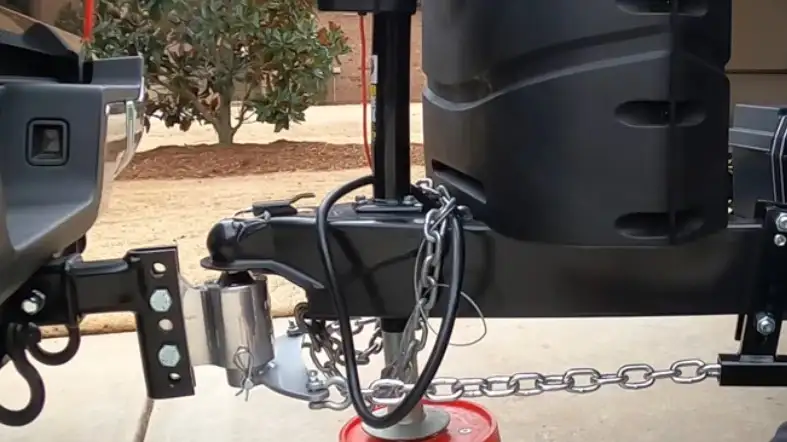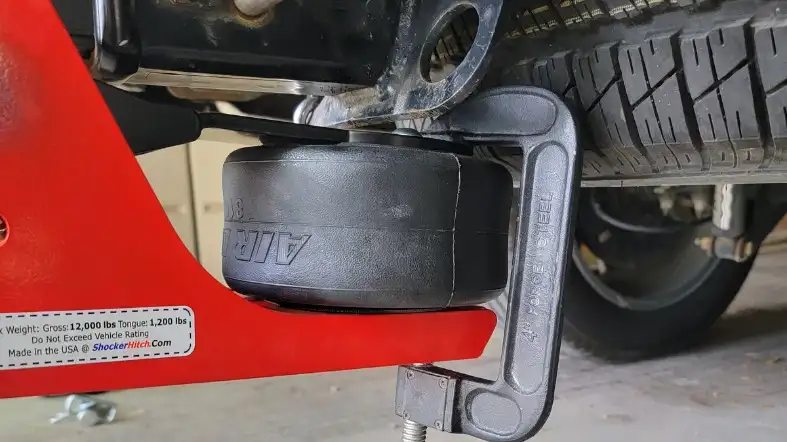If you own a trailer or RV, you may have heard of weight distribution hitches as a way to evenly distribute the weight of your load and improve stability on the road.
But what if you already have air bags installed on your vehicle?
Do you still need a weight distribution hitch?
In this blog post, we’ll explore the potential benefits and drawbacks of using both weight distribution hitches and air bags together, and help you decide which option is best for your specific needs.
Do you need a weight distribution hitch if you have air bags?
Yes, if you have air bags on your vehicle, you may still need a weight distribution hitch in order to evenly distribute the weight of your load across all axles.
While air bags help keep your vehicle stable and level, they are not able to distribute weight evenly.

However, by using a weight distribution hitch, you can ensure that the weight is evenly distributed, preventing sway and ensuring stability while driving.
This is especially important if you have a large load or are towing a trailer.
Weight distribution hitch vs airbag:
If you have bought a pickup truck recently, it may have an airbag.
So, before you decide on skipping the weight distribution hitch when towing, you need to know how these two systems work.
So, we will drill through their functions and differences here.
It will help you understand which one of the two systems is essential for you.
The Function Of Airbags:

The primary function of the airbags is to regulate the air pressure at a certain level to ensure safe driving.
Put another way, the primary function of the airbags on your truck is to maintain the level of your vehicle.
Following the loading of the tow vehicle and the addition of weight behind the back wheel, the vehicle may present you with a series of problems.
The rear of the tow vehicle can start to sag. If it sags, the tow vehicle can change its angle and lead to serious consequences.
So, to deal with the risks and offer safety to the vehicle and driver, we can use airbags.
It works as a balloon:
When we tow something, there is a load on the airbags. As the load gets heavy, an airbag acts in a manner analogous to that of a balloon.
It immediately pushes air into the airbag in order to prevent the truck from crouching down.
If you are not going to be towing, you simply easily deflate the airbag by opening the valve. Sounds interesting, isn’t it?
Keeping The Vehicle Level:
When we transport or tow something, the airbag suspension systems can bring the entire vehicle back to its original level pitch.
So, it regulates the air pressure in such a way that the ride gets more stable and comfortable
Airbags Offer The Needed Support:
Towing systems that include airbags allow for more flexibility in driving style when the vehicle is being hauled.
When your car’s suspension isn’t up to the task, towing high weights can lead to a number of problems.
It can even cause difficulty in maintaining control of the vehicle.
So, an airbag may help you right away in such situations. You can avoid issues like sluggish stopping or acceleration, as well as.
To sum up, airbag systems are advantageous in a range of conditions.
The roads are not the same and you never know what the unknown roads have for you.
In fact, our vehicles could occasionally benefit from the extra assistance.
It can never replace the weight distribution hitches:
Airbag suspension systems only modify the way a vehicle drives under pressure.
It has nothing to do with the towing capacity or the payload ability of the vehicle.
The Function Of Weight Distribution Hitch:

A weight distribution hitch’s primary function is to bring both the towing vehicle and the trailer back into a state of equilibrium.
When we hitch up or link our trailer to a tow vehicle, we add additional weight to the rear of the vehicle.
The addition of the trailer places additional strain on the rear axles of the vehicle.
On the other hand, the front axels don’t feel much pressure
As a result, the front of the car being towed rises, which makes it more difficult to steer and applies less pressure to the brakes.
Also, the weight of the trailer causes the rear of the tow vehicle to sag.
The same also affects the suspension system of the vehicle, which could lead to a serious accident in no time.
This is where the weight distribution hitches come into action.
They distribute the weight all over the vehicle and prevent sags.
Thus, they keep the vehicle level and offer safety to the trailer, vehicle, and driver.
It plays the role of a bridge:
A weight distribution hitch works as a bridge between the trailer and the towing vehicle.
It is also a bridge between the rear axles and the front axles.
It takes away the load from the rear axles only to pass it to the front axles.
It simultaneously restores the weight on the front axles that we lose when we link the trailer and the towing vehicle.
So, there is a balance that prevails to ensure a safe towing experience.
It Reduces Stains On The Suspension:

Weight distribution hitches typically consist of steel arms.
The sole purpose of these steel arms is to reduce the amount of strain that the additional trailer weight puts on the suspension.
Utmost leveling of the vehicle:
The frame of the trailer receives two L-shaped brackets.
These are the hooks that we secure on the trailer frame by using heavy-duty bolts. So, it further reinforces safety.
The hitch head plays a very significant role here.
The steel arms go through to the hitch head only to link up to the coupling point.
Finally, the steel arms, being through the coupling point rest on the trailer frame brackets.
This is the mechanism that brings the weight distribution back into balance.
All the axles of the vehicle get the same amount of pressure in the process.
The trailer and the towing vehicle remain level throughout the journey this way.
It Can Do Everything An Airbag Does:
Weight distribution hitches distribute the weight throughout the entire vehicle and level the vehicle.
So, they prevent the sags and influence the way a vehicle operates while towing. So, a weight distribution hitch excludes the need for airbags.
Which one do I need?
Weight distribution hitches boost a vehicle’s ability to steer and brake, as well as the vehicle’s overall control.
The suspension provided by airbag systems is easily changeable and can be adjusted to provide the best possible driving experience.
These two systems are able to cohabit sometimes and may even provide an amazing experience when it comes to towing.
However, the fact that there will be redundancies is of concern.
As you already know, you don’t really need airbags if you have a weight distribution hitch.
When it comes to towing, a weight distribution hitch on its own can offer comparable and the same advantages as airbags.
But the opposite is not true when it comes to airbags that are not paired with a weight distribution hitch.
Downsides Of Using The Two Systems Together:

Automatic leveling using airbags hurt the weight distribution hitches.
A weight distribution hitch might lose somewhere in the range of 25 percent of its established weight distribution in this process.
The weight distribution percentage is very important here. If you attach the hitch above this level, you have the good sides.
The vehicle will still comply with the safe towing framework prescribed by the manufacturer.
Airbags are unable to spread the weight to the entire vehicle from the back axle.
Even if you have an airbag system, you should still use a weight-distribution hitch to ensure that you have the safest possible trip.
Safety tips:
It is important to turn off the tow vehicle’s automatic airbag suspension before attaching a weight distribution hitch.
When the installation is complete, you can turn the system on.
The top engineers also advise setting the weight distribution between 75% and 100% to account for auto-leveling.
To ensure the highest possible level of protection during towing, it is imperative that all rules provided by the manufacturer are adhered to.
FAQs About Weight Distribution Hitch And Air Bags:
Is It OK To Use Airbags With A Weight Distribution Hitch?
You can use one, but it will only offer what the weight distribution hitch already offers.
Are Airbags Worth It For Towing?
Yes, the manages the load on the vehicle and helps with the control of the vehicle.
So, not a bad investment in the absence of a weight distribution hitch.
Is A Weight Distribution Hitch Alternative For Airbags?
A weight distribution hitch is not only the alternative but rather the better between the two and the best for towing.
Final Words:
So, the need for a weight distribution hitch has been questioned and the answer is very obvious now.
Even if you have automatic airbag suspension systems in your truck, you will still need a weight distribution hitch to ensure the utmost safety of the vehicle and yourself.
In reality, a weight distribution hitch excludes the need for airbags.
On the other hand, airbag systems may complement a weight distribution hitch in some cases.
However, it can never replace a weight distribution hitch.
